












This exceptional property offers a unique opportunity to embrace the coveted Marlborough way of life, with a sizable land holding held in two titles includes a thriving 12.6ha vineyard to supplement your aspirations. Situated in desirable Hawkesbury, this executive residence welcomes you to a world of comfort and sophistication. Boasting 240sqm of permanent material construction, this solid family home is designed to cater to your every need, with two spacious family living areas and five bedrooms providing ample space for relaxation, work, and play. Step outside into your own private oasis, where a refreshing pool awaits, beckoning you to unwind and enjoy Marlborough’s climate while enjoying effortless entertaining on the elevated deck overlooking the vines. Adjacent to the main residence, a separate studio offers endless possibilities, serving as a tranquil Airbnb retreat for guests or a convenient work-from-home space. This versatile studio adds both value and flexibility to your lifestyle, allowing you to maximize your property's potential and income. In addition to its exceptional living spaces, this property also features ample shed storage, providing a secure place to house all your possessions from campers and boats to tractors and more. Supporting this lavish residence is 12.6ha vineyard consisting of mixed varietals, with convenient 3m rows and a sizable water right, consistently producing quality fruit and tonnages this asset is sizable to provide a lucrative income stream, and further future proofed by the two titles. This location offers the best of both worlds, with the tranquility of rural living just minutes from the Renwick amenities and Blenheim CBD. Whether you're exploring the local wineries, or simply enjoying a leisurely stroll along the river, everything you need is within easy reach. Don't miss this opportunity to live a Marlborough lifestyle of your desire with our vendors relocating. Contact us today to arrange a viewing and start making memories in this stunning Hawkesbury property.


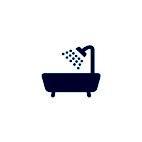





 Prospr autonomous tractor. Photo Jim Tannock
Prospr autonomous tractor. Photo Jim Tannock

Cover: The 2023-2024 growing season was a “testbed” for Cloudy Bay’s autonomous vineyard tractor V3. “The quality of the jobs completed rivalled that of conventional tractor operations,” says Cloudy Bay vineyard innovation and engineering manager Murray Faber. Photo Jim Tannock. See page 16
WinePRO will be an opportunity to explore cutting edge technology already at play in New Zealand’s wine industry, and to hear about developments, initiatives and future aspirations.
18
Finishing touches are being made to a future-focussed vineyard lab able to simulate climate change, including advancing growth by up to four weeks, says Plant & Food Research’s Damian Martin.
The attributes that drive success early in a career can be the same ones that “burn you out” later on, says performance and resilience expert Nick Petrie. If people don’t learn to update their approach to work, and operate “in much smarter ways”, they are at high risk of burn out.
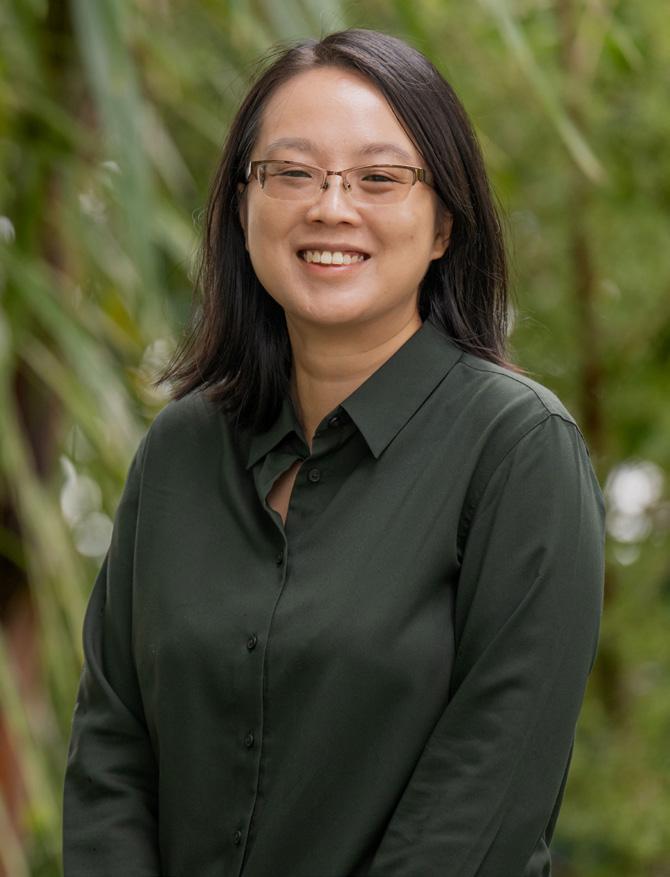

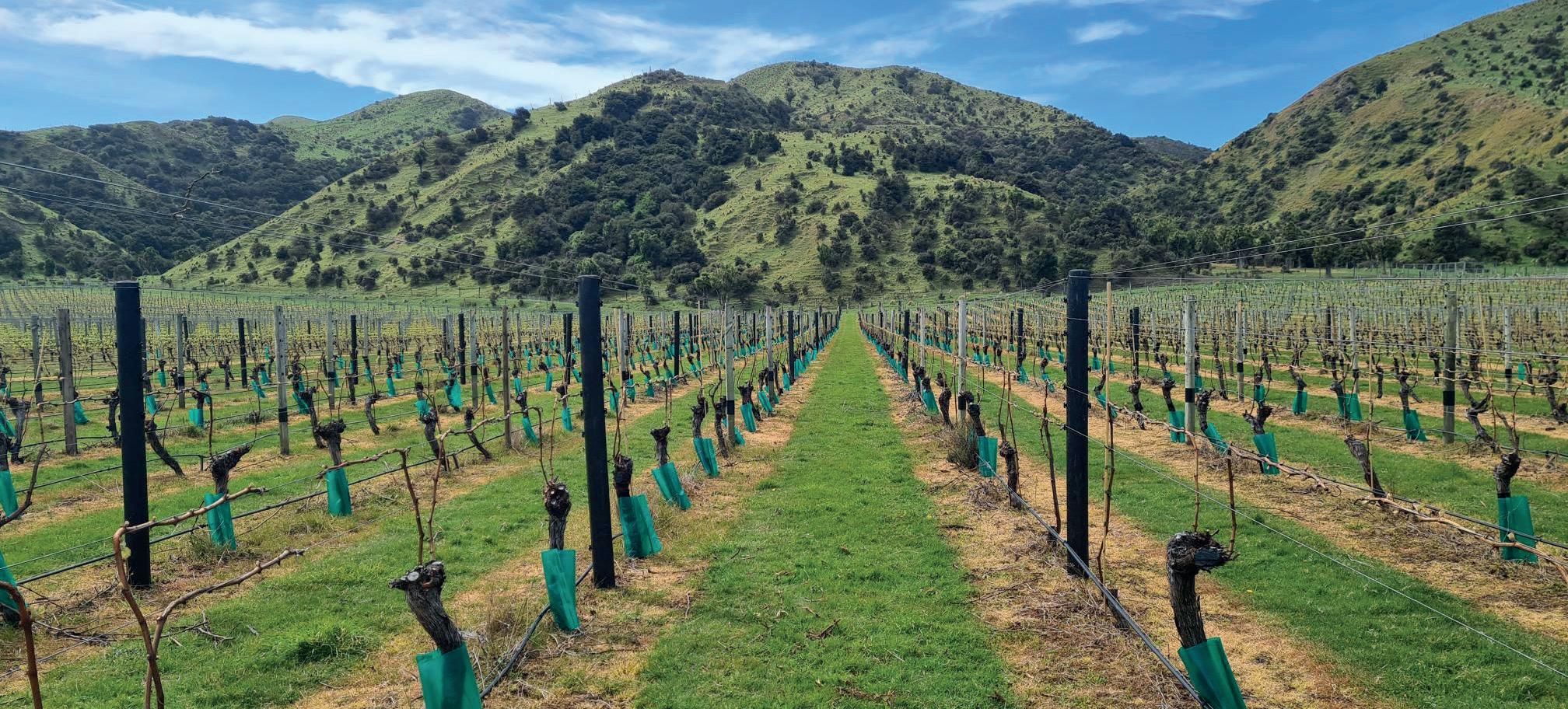


General Manager:
Marcus Pickens 03 577 9299 or 021 831 820 marcus@winemarlborough.nz
Editor:
Sophie Preece 027 308 4455 sophie@sophiepreece.co.nz
Marketing and Communications: Sarah Linklater 021 704 733 sarah@winemarlborough.nz
Events Manager: Loren Coffey loren@winemarlborough.nz
Advocacy Manager: advocacy@winemarlborough.nz
Advertising: Joanna May advertising@winemarlborough.nz
Grape Grower Directors: Andrew Nation nationa@gmail.com
Bryn Cotching breezemere@hotmail.com
Michiel Eradus michiel@eraduswines.co.nz
Nigel Sowman nigel@dogpoint.co.nz
Tracy Johnston tracy@dayvinleigh.co.nz

Wine Company Directors: Beth Forrest beth@forrest.co.nz
Damien Yvon damien@closhenri.com
Drew Ellis drew@mggcoop.co.nz
James Macdonald james@hunters.co.nz
Jamie Marfell Jamie.Marfell@pernod-ricard.com
Designed by: Blenheim Print Ltd 03 578 1322
Disclaimer: The views and articles that are expressed and appear in Winepress are entirely those of contributors and in no way reflect the policy of the Marlborough Winegrowers. Any advice given, implied or suggested should be considered on its merits, and no responsibility can be taken for problems arising from the use of such information.
This document is printed on an environmentally responsible paper, produced using elemental chlorine free (EFC), third party pulp from responsible sources, manufactured under the strict ISO 14001 Environmental Management System and is 100% Recyclable.

IT’S BEEN nearly nine years and exactly 100 editions since I took over Winepress from former editor Tessa Anderson in November 2015. I can hardly believe so many years have passed since I filed that first magazine, with a story on the launch of the seven-year Vineyard Ecosystems Programme, and VineFacts going national, with Rob Agnew providing essential data to growers around the country. Rob’s own tenure in Marlborough research is an extraordinary 38 years, including 32 years producing the Met Report for Winepress, surely the most read pages of this magazine. As if researching and relaying information for his reports was not enough, Rob has always taken time to talk me through the weather and vines, quietly, diligently and generously sharing his knowledge. I wish him all the best for his retirement. The good news is that Victoria Raw, another dedicated weather watcher, is ensuring the MetReport and VineFacts continue to serve Winepress readers and the wider industry.
Hitting 100 editions seems like a good time to bring a fresh perspective to Winepress, so I’d like to welcome the new editor Bev Doole, an experienced journalist and project manager who began her journalism career in 1983 as a cadet at The Marlborough Express, followed by the Evening Post in Wellington and Financial Times in London. When she returned to Marlborough in 2008, the region’s landscape had changed a great deal, thanks to the growth of the wine industry. Bev spent some time working in the Spy Valley and Mahi cellar doors, before taking up project management roles, including on the Marlborough Landscape Group, and 10 years as the coordinator of the Cawthron Marlborough Environment Awards. That opened her eyes to some of the great initiatives happening in the wine industry and other sectors, says Bev, whose passion for the environment extends to how it interacts with industry and business. “I think it’s in everyone’s interests that they are working together. That’s where I found the Marlborough Environment Awards such an inspiration.” She’s looking forward to continuing that “sharing of knowledge” in her role at Winepress, “finding good stories and finding ways to share good practice and inspire”.
The past 100 editions have flown by for me, thanks to an industry rich with inspirational individuals, future-focused initiatives, and environmental aspirations worth writing about. This final one could easily have been filled twice over, with its technology focus, centred on WinePRO, spoiling me for choice. Thankfully I will still be writing about the wine industry through Winegrower Magazine, so will get to dive into the wonderful WinePRO programme in June, with its stellar line up of erudite speakers, from sociologist Paul Spoonley to Simplicity founder Sam Stubbs, and discussions ranging from AI to Circular Wine.
In the meantime, thanks to those who have let me tell their stories over the past nine years, and of course to those who have read them. I’d also like to thank the tireless team at Wine Marlborough, and the wonderful Jim Tannock, whose images have made Winepress look pretty fabulous for the past 20 years. I look forward to reading the next edition Bev!
SOPHIE PREECEIt’s
time to brace for the flood (of data and technology)
says Peter Terpstra, Indevin Group chief technology officer.

A PRESENTER at the 2019 Australian Wine Industry Technical Conference (AWITC) described research and development in the wine industry as “too much R, not enough D”. It was an observation that many new technologies were being presented in the lecture hall but not available in the trade hall. What we are seeing now is all that promising research and those prototypes becoming commercially available. This ultimately means there is a massive amount of data and opportunity coming our way – geospatial operational data, yield by the meter, SCADA (supervisory control and data acquisition) systems, chemometric analysis, new sensing technologies, autonomous vehicles, satellite imagery, high resolution photography and real time analysis…
To recognise return on investment in these new technologies, there will be some initial challenges. Firstly, how do we ensure we easily and consistently automate collection and storage of the data being produced by these systems? Secondly, how do we ensure the ingested data can be used as a baseline of how we operate, to simultaneously improve quality and sustainability while also reducing cost, either through process improvement or increased yields?
The first cab off the rank will be assessing how these new technologies work with our operational teams. While some, like yield measurement, will simply be added to existing activities, others like autonomous equipment will need data to ensure their operation can practically deliver the required overall equipment effectiveness (OEE) and thus return on investment.
The wine industry is a data scientist’s ultimate challenge and differs from more linear business models because there are so many moving parts between the vineyard and the bottle on shelf. It also differs because it is a game of educated trade-offs where the ultimate predictive model can only ever hope to make the bucket of decisions viticulturists and winemakers are faced with, smaller and more focused. Art and experience supported by science and technology.
Due to the increasing variability of harvests brought about by climate change, Indevin Group is investing in
developing technology that facilitates this mix of art and science. One recent planning tool was designed to baseline Indevin’s harvest execution, with the simple goal of maximising quality by harvesting fruit as close as practically possible to its targeted specification. Interestingly, this tool was initially developed to handle above average vintages and the potential avalanche of fruit, but has also proven beneficial in lower yielding vintages like V24 because the accelerated maturity required the planning process to be even more agile to achieve this goal.
Setting a baseline to measure any process takes time and investment but is crucial to measure effectiveness, identify opportunities and establish trials to stress test solutions. Success in this endeavour requires intestinal fortitude from not only the technologists, but also management, viticulture and winemaking. That said, there are quick wins available, and Indevin Group has seen great strides in planning, performance and troubleshooting with robust reporting dashboards of shift performance.
We cannot talk about technology without mentioning the current excitement surrounding automation and AI. While both are admirable goals to achieve in a labourconstrained world, there is an obvious progression; starting with a manual process, becoming mechanised, moving to automation, then optimising using continuous improvement, before maybe one day handing this off to AI. There is danger in initiatives that assume we can jump a step or two.
New Zealand’s relative youth in the world of wine has always given us license to challenge the status quo. With the challenges of climate change, labour scarcity and shifting consumer preferences, the wine industry will need to use every advantage available to us. It is in Kiwis’ – and certainly Indevin’s – DNA to strive to be better by trying something new. There are many technological opportunities to support continual improvement in how we produce world-renowned wine, and it is important that we look to take advantage of these as the game changes around us.
Stewart Maclennan, senior winemaker at Saint Clair Family Estate, is helping steer Marlborough Wine Industry Wellness Week (May 27-31), to celebrate initiatives that help bolster the mental and physical wellbeing of the wine workforce. Here Stewart looks at the role of industry leaders in enhancing workplace wellbeing.
Have you seen a change in industry focus following the inaugural Wellness Week last year?
It has generated a lot of positive conversation and I’ve heard of initiatives from the week being mirrored where they might not have been otherwise. The causality of culture change is a hard one to pin down, but I think it’s safe to say that work cultures in general are improving over time. Wellness Week is primarily about celebrating that and sharing around a bit of wisdom and ideas, so we can highlight what’s good and improving in our industry, as well as cut down on lead time for the wider community. What are some examples of good initiatives?
So much is generated out there by people that are just passionate about creating initiatives that benefit their people and organisation; often that person is doing it purely from a place of experience and care and asking them to post it up for everyone to see might not be their natural inclination. I’ve heard of some amazing initiatives that haven’t been shared yet, but last year I was happy the judges picked a simple food sharing idea as one of the winners, described as “an excellent example showcasing that supporting wellbeing in the workplace does not need to be complicated or costly”. I also loved hearing about more quiet spaces being made available for people to take meaningful breaks.

Does a low yielding vintage take pressure off?
In many ways, Wellness Week and the culture of improvement in general is a reaction to the fast growth and bumper seasons experienced by our industry. This season was incredible – a balanced yield, and clean, ripe fruit, certainly translates into relative ease for most. I’m certain most people feel they were able to bounce back quick after this one, but there’s never a downside to working smarter and building more resilience in a workforce. Make hay while the sun shines, I reckon; leaders can take this opportunity to ask things like, ‘what are the main takeaways from this season that left the team in good shape, and how can we lean into that in the future?’
What role do industry leaders have in driving a culture of care?
I think modern leadership understands better than ever the long-term practicality in driving a healthy culture of care. New Zealand, like anywhere, has some deeply embedded working cultures, but we’re also small and can adopt change quickly. Towards anything, leaders can either be a roadblock, allow it, or get amongst it. The benefit of ‘getting amongst it’ is that you’re promoting a culture of community and safety from the front, which opens the door for increased engagement, communication, productivity, and initiative from your people.



Table 1: Blenheim Weather Data – April 2024
GDD Total
Jul 23 - Apr 24 -
1 Growing Degree Day (GDD): Max/Min are calculated from absolute daily maximum and minimum temperatures
2 Growing Degree Day (GDD): Mean are calculated from average hourly temperatures
April’s mean temperature of 13.3°C was 0.3°C below the LTA temperature of 13.6°C. Only the second week of the month had above average temperatures predominantly driven by the warmer than average minimum temperatures. Overall, April had cooler daily average maximum temperatures. The daily minima
for the first two weeks were above average but then plummeted; from 1 to 15 April there were 5 overnight temperatures below the LTA compared with 12 nights from 16 to 30 April.
The coldest morning in Blenheim was on 28 April with an air minimum temperature of 0.4°C and grass minimum temperature of -2.4°C. This was the first ground frost of the year. 10 April recorded the month’s top temperature of 23.9°C.
Blenheim recorded 193.4 hours sunshine in April, 100% of the LTA. Blenheim came fourth in the monthly sunshine stakes, 12.6 hours behind Napier, which was April’s top poling position followed by Whakatane and New Plymouth. However, it was the South Island’s sunniest town for April 2024.
Total sunshine for Blenheim from January to April 2024 was 1060.4 hours, this was 116% of the LTA of 915.9 hours.
For the first four months of 2024 Blenheim was leading the sunshine race, 9.8 hours ahead of Richmond, its closest rival, followed by New Plymouth. The top of the South Island (Blenheim, Richmond, Appleby and Takaka), for the first third of 2024, has a leading edge over most of the other main regional towns that record sunshine.
Blenheim recorded 72.2 mm rain in April, 149% of the LTA (48.3 mm). The previous four Aprils recorded below average rainfall. April 2024 recorded just 4 days of rain (days with 1.0 mm or greater rainfall). The LTA number for April is 5.6 rain days.
Total rainfall January to April 2024 was 116.4 mm, 65% of the LTA. Total rainfall January to April 2023 was 192.0 mm. Soil Moisture
Average shallow soil moisture (5-35 cm depth) at the Grovetown Park weather station during April was 26.5%. This was above the LTA April value of 24.9%. On 1 April it was 15.6% and on 30 April it was 29.1%. The rain on 11 to 13 April boosted the soil moisture back to a maximum of 36.2% and it has remained around 30% since then.
Season Weather Summary (September 2023 to April 2024)
Table 3 summarises the eight months of the growing season, September to April. These data are taken from the Blenheim weather station as it has long term records to be able to produce comparisons between the current growing season and the long-term average (LTA). Daily data and monthly summaries for the Blenheim and Dashwood weather stations can be found on the Marlborough Research Centre website: www.mrc.org.nz
Table 3: Monthly weather summary for Blenheim for the 2023-24 growing season in comparison with the long-term averages
LTA – 1986-2023 for rain, temperature, growing degree days (GDD) and sun LTA – 1996-2023 for evapotranspiration (ET)
Growing season temperature and growing degree days
For much of Marlborough the grape-growing season will have been from mid-September 2023 until mid-April 2024, unlike previous years when this would have been closer to the end of April. This more compact growing season was largely driven by the shorter fruit ripening period, predominantly due to the lower than average yields that the vines were carrying.
From September 2023 to April 2024, September, November, December, January and February recorded above the monthly mean temperatures but March and April were well below the monthly means. Although there were only 2 days between December and February above 30°C, there were 46 days that recorded above 25°C compared with 17 and 27 in 2022-23 and 2021-22 summers. The total number of growing degree days (GDD) in 2023-24 were 1342 GDD; 2022-23 = 1398 GDD; 2021-22 = 1429 GDD.
Figure 1 indicates that in mid-September 2023 there was a week of warm weather followed by a week of cool weather
(black spike). From October until mid-December the GDD remained close to the LTA. From then until the end of January 2024 there was a rapid increase in GDD. From February and until mid-March it remained close to average but then declined until the end of April. 2011-12 was a cool season as the GDD were consistently below average. From 2013-14 onwards (not all years are shown) the seasons have recorded above average GDD for most of the growing season. Warmer than average seasons are rapidly becoming the new normal.
Since spring 2004, Plant and Food Research has been monitoring the phenology and yield of four Sauvignon blanc blocks in Marlborough, that are 2-cane pruned. This has provided a rich repository of data. Using the data gathered from a block in Central Rapaura, in 2023-24, it reached 50 % budburst on 26 September (equal earliest, 20-year average: 3 October); 50% flowering on 5 December (20-year average: 6 December); 8 °Brix on 3 February (third earliest, 20-year average: 10 February); 21.5 °Brix on 3 March (earliest, 20-
year average: 23 March). There were 159 days between 50% budburst and 21.5 °Brix making this the shortest season since monitoring first started (20-year average: 173 days). The phenophase between 8 °Brix and 21.5 °Brix was the briefest at just 29 days, driven by the low yield of 3.9 kg/ vine (the second lowest recorded).
From September 2023 to April 2024, September, November, December, January and February recorded above the monthly mean temperatures but March and April were well below the monthly means. Although there were only 2 days between December and February above 30°C, there were 46 days that recorded above 25°C compared with 17 and 27 in 2022-23 and 2021-22 summers The total number of growing degree days (GDD) in 2023-24 were 1342 GDD; 2022-23 1398 GDD; 2021-22 1429 GDD
Figure 1 indicates that in mid-September 2023 there was a week of warm weather followed by a week of cool weather (black spike). From October until mid-December the GDD remained close to the LTA. From then until the end of January 2024 there was a rapid increase in GDD From February and until mid-March it remained close to average but then declined until the end of April. 2011-12 was a cool season as the GDD were consistently below average. From 2013-14 onwards (not all years are shown) the seasons have recorded above average GDD for most of the growing season Warmer than average seasons are rapidly becoming the new normal.

Figures 2 compares the average dates for each of the phenology stages between the first 10 years (2004-05 to 2013-14) with the subsequent 10 years (2014-15 to 2023-24). A consistent shift to earlier dates of 50% budburst, 50% flowering, 8°Brix and 21.5 °Brix occurred in the latter period. Although there will be both early and late years in each of these comparisons there is nonetheless a movement towards earlier phenology and shorter growing seasons. What will the pattern be for next 10 seasons? Only time will tell.
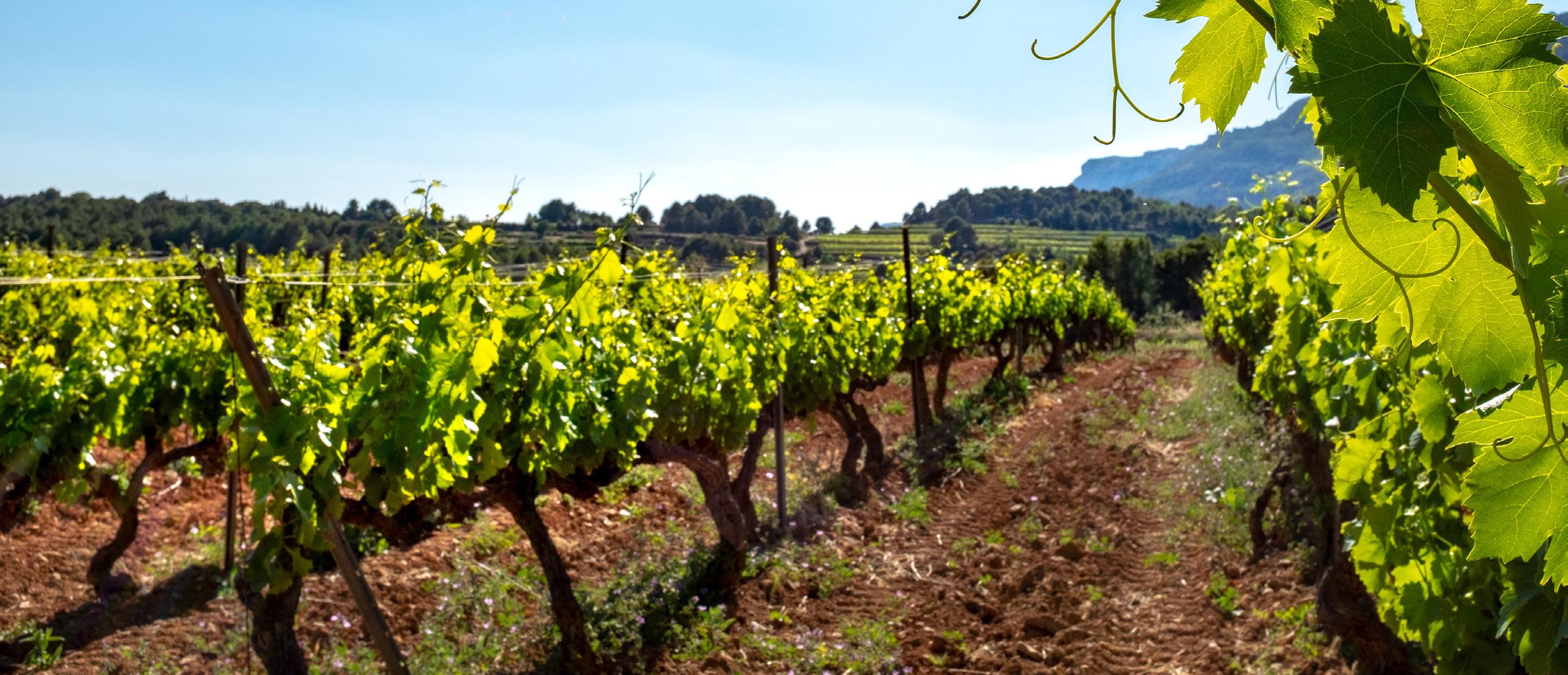
Figure 1: Normalized Growing degree days for Blenheim: days above (+) or below (-) the long-term average (1990-91 to 2022-23) for the period 1 September to 30 April
Phenology
Figure 1: Normalized Growing degree days for Blenheim: days above (+) or below (-) the longterm average (1990-91 to 2022-23) for the period 1 September to 30 April
Since spring 2004 Plant and Food Research has been monitoring the phenology and yield of four Sauvignon blanc blocks in Marlborough, that are 2-cane pruned. This has provided a rich repository of data. Using the data gathered from a block in Central Rapaura, in 2023-24, it reached 50 % budburst on 26 September (equal earliest 20-year average: 3 October); 50% flowering on 5 December (20-year average: 6 December); 8 °Brix on 3 February (third earliest, 20-year average: 10 February); 21.5 °Brix on 3 March (earliest 20-year average season °Brix was
Figures
201 budburst, 50% flowering, 8°Brix and 21.5 °Brix occurred early and late years in each of these comparisons there is and shorter growing seasons. What will the pattern be for next 10 seasons? Only time will tell.
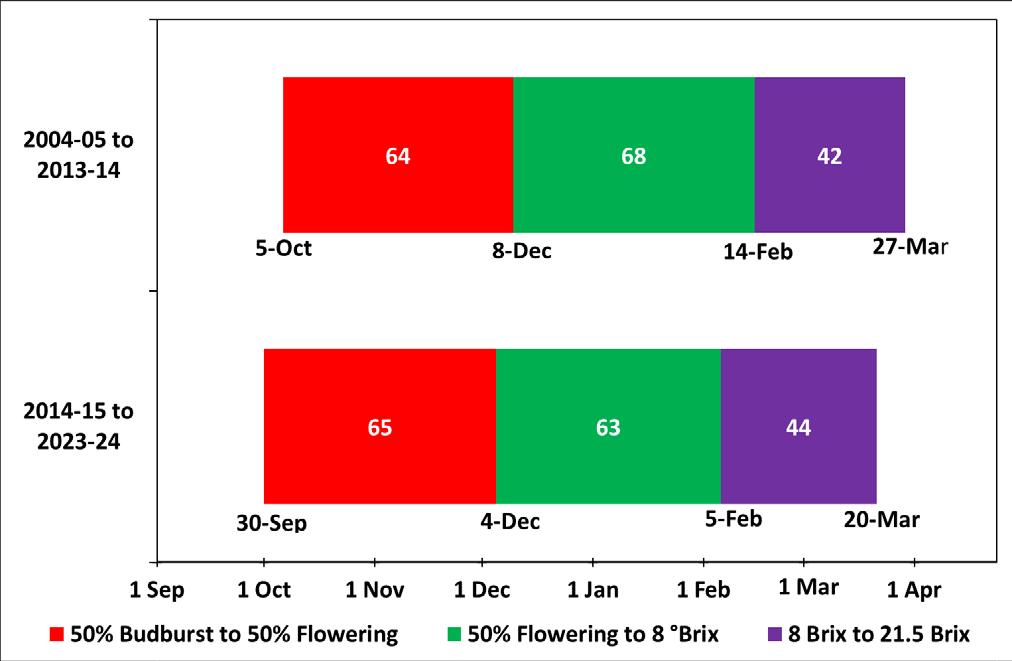
The consistently below average rainfall and above average evapotranspiration (ET) rates from September to April has seen the region’s dry pastoral farming suffer from drought conditions. On 14 March the Minister for Agriculture, Todd McClay, declared that there was a ‘medium-scale adverse event’ for Marlborough, Tasman and Nelson. Despite 72.2 mm in April this will not have been enough to break the drought, even though water restrictions have been removed and soil moisture was 29.1 %, on 30 April. According to Charlotte Tomlinson, a hydrologist at the Marlborough District Council, this one rain event was not sufficient to replenish the Wairau aquifer (https://marlboroughapp.co.nz/news/drought-not-broken).
Figure 2: Comparison of average phenology dates and phenophase lengths (number of days) between 2004-05 to 2013-14 and 2014-15 to 2023-24 seasons
Growing season rainfall and evapotranspiration
Figure 2: Comparison of average phenology dates and phenophase lengths (number of days) between 2004-05 to 2013-14 and 2014-15 to 2023-24 seasons

With consistently below average rainfall and above average evapotranspiration (ET) rates from September to April has seen the region’s dry pastoral farming suffer from drought conditions. On 14 March the Minister for Agriculture, Todd McClay, declared that there was a ‘medium-scale adverse event’ for Marlborough, Tasman and Nelson. Despite 72.2 mm in April this will not have been enough to break the drought, even though water restrictions have been removed and soil moisture was 29.1 %, on 30 April According to Charlotte Tomlinson, a hydrologist at the Marlborough District Council, this one rain event was not sufficient to replenish the Wairau aquifer (https://marlboroughapp.co.nz/news/drought-not-broken).
Figure 3 compares the seasonal (September to April) rain for 2022-23 and 2023-24. The 2022-23 season recorded 368.8 mm rain, 95% of the LTA The monthly rain in 2022-23 was unevenly distributed; with September, October, February and April below average; December close to average; and November, January (due to the tail-end of Cyclone Gabrielle) and March above average. In contrast, 2023-24’s total was 233.8 mm, just 60 % of the LTA Monthly rainfall was less than the LTA for most of the growing season, except for April In 2021-22 there was 415.4 mm rain, 107% of the LTA

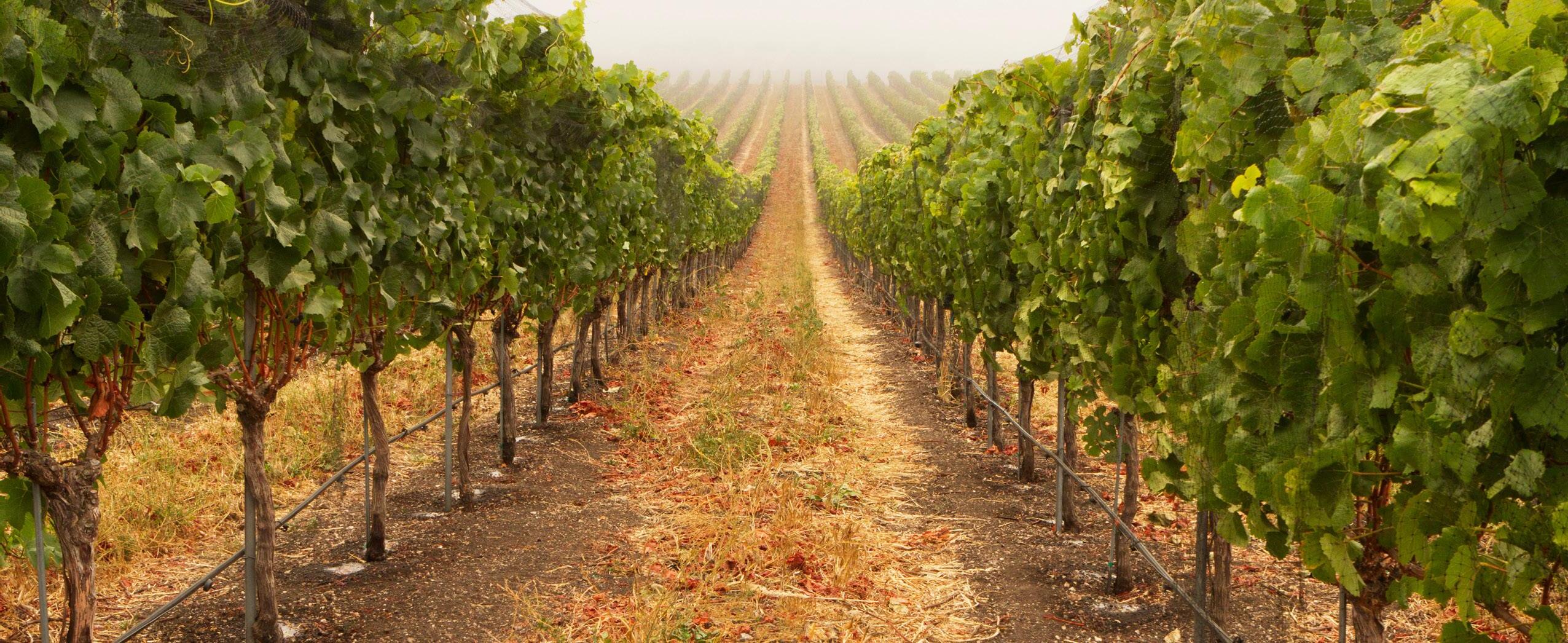






FROM LESSONS in electrification to innovations in filtration, and from environmental certification to artificial intelligence, WinePRO’s conference programme reflects the energy and evolution of New Zealand’s wine industry, says Wine Marlborough general manager Marcus Pickens. “The theme is Innovate, Elevate, Celebrate, and we have an incredible lineup of speakers delving into a wide array of developments, initiatives and future aspirations, against a background of economic, demographic and climate data. It’s a valuable opportunity to learn about what’s here and what’s on the horizon.”
WinePRO is on in Blenheim from June 25 to June 27, with more than 70 suppliers displaying the latest innovations and technologies, while the education programme offers more than 21 expert speakers and panelists, including New Zealand Story’s David Downs, BERL’s Amanda Read, social scientist Professor Paul Spoonley, Simplicity’s Sam Stubbs, and Kiwibank New Zealander of the Year 2024 Dr Jim Salinger, a climate expert who’ll discuss the outlook for viticulture.
“It will be a tough task deciding which sessions to attend,” Marcus says, noting that opening day starts with Rewiring Aotearoa’s Mike Casey talking about his electric cherry orchard in one room, while Rachel O’Shea from Yabble discusses AI in global wine research, innovation and markets in another. Meanwhile, BNZ chief economist Mike Jones will present a snapshot of the current economic climate, along with forecasts for the future. Entry to the WinePRO trade expo is free, but attendees will need to book for the education programme, with one or three day passes available.
Many of the exhibitors at the expo will provide a smooth segue from podium to practicalities, with AI, autonomous vehicles, and cutting-edge winery and vineyard tools to be showcased by science and agritech developers. Integrape and Plant & Food Research will introduce industry to the new VinEye technology designed to detect grapevine leafroll disease (page 12), while HortPlus will present its free online tool – Changing Climate: Disease Risk & Costs. Robotics Plus and Croplands will have the autonomous, multi-use, hybrid vehicle Prospr on display, highlighting its myriad vineyard functions. “It is crucial to get the industry involved in new technology innovation early,” says Robotics Plus co-founder and chief executive Steve Saunders of being at WinePRO. “Growers are innovators, and they are looking at different ways to
Attendees at WinePro can learn about the reality and future of autonomous vineyard vehicles in the education sessions, then see the likes of Prospr in the expo. Photo Jim Tannock
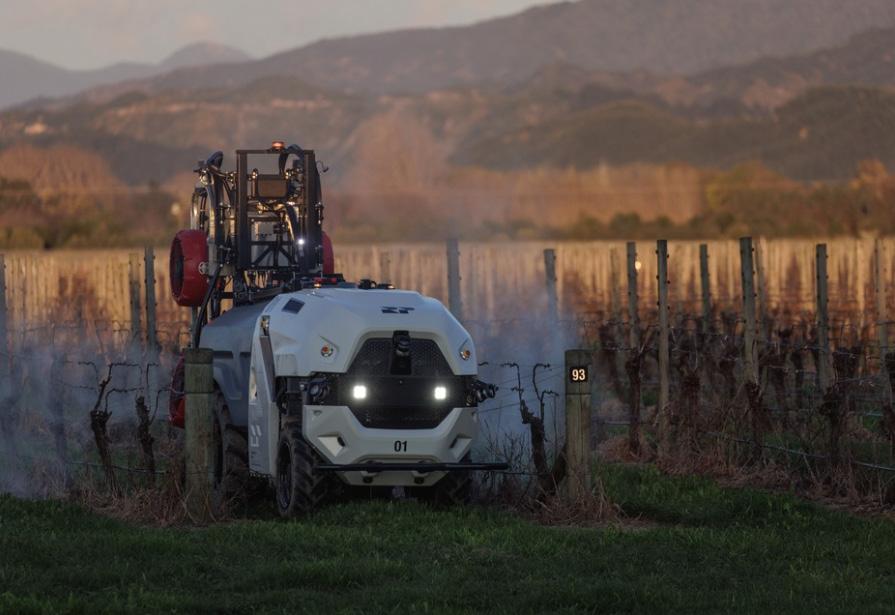
transform and grow for automation that addresses key pain points.”
Attendees can stroll from Prospr to the education session on autonomous vehicles, with Cloudy Bay’s Brock Campbell (see page 16) joining Josh McCulloch of Autonabit and Andrew Kersley of Smart Machine to ask, “what is the big dream, and where could it go?” The programme includes experts from the coalface in Marlborough, including Jim White from Cloudy Bay, and Tracey Marshall from Pernod Ricard Winemakers discussing Circular Wine, and viticulturist Stuart Dudley, joined by an industry panel, discussing the dos and don’ts of vineyard redevelopment. In curating the education programme, Wine Marlborough and Marlborough District Council relied on the expertise and insights of a steering group, comprised of Tracy Atkin, Heath Stafford and Ben McLauchlan, who’ve helped deliver a world class programme, Marcus says. WinePRO organiser Gary FitzRoy, of Expertise Events, says WinePRO is a “celebration and tribute” to New Zealand's wine sector. “As participants immerse themselves in the world of WinePRO New Zealand, they’ll experience firsthand the passion and dedication that make New Zealand a global powerhouse in wine production.” winepro.co.nz
The 16th annual Grape Days Marlborough will be held in Blenheim on June 24, offering winegrowers insights into industry research they can take into the field, and consider into the future. “This year we are focusing back on the key outcomes of industry research, presenting some near-term and long-term messaging for the winegrower members,” says Bragato Research Institute (BRI) knowledge transfer and engagement leader Braden Crosby. The programme will conclude some of BRI’s medium-term projects on alternatives to cane pruning and grapevine remediation, as well as looking at rootstocks and drought tolerance, vine improvement nationally and internationally, and findings of both the Pinot Noir and Vineyard Ecosystems programmes. nzwine.com/en/initiativesevents/research/grape-days

June 25-27, 2024
Marlborough Lines Stadium 2000, Blenheim
Over 3 days, WinePRO will showcase the latest products, new technology, and connect leading suppliers with members of the wine production industry.




Whether you’re a winegrower, winemaker, vineyard manager or any other member of the wine production industry, WinePRO is the event you don’t want to miss!
Discover the latest equipment, services, sustainability measures, automation and so much more.





Learn from industry leaders with key knowledge. One sentence or piece of knowledge could change the trajectory of your business.
Connect with new people and suppliers in the industry and maybe finally put a face to an old name.



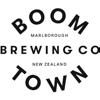


ARTIFICIAL INTELLIGENCE could be faster, cheaper and more accurate than trained experts when it comes to spotting grapevine leafroll disease in New Zealand vineyards, says Plant & Food Research plant pathologist Dr Karmun Chooi. “I see a huge potential for agritech to be used even more in the future for disease management,” explains the project leader for VinEye, an algorithm developed in partnership with Kiwi agritech company Integrape to analyse photographs of grapevines and identify grapevine leafroll disease (GLD).
The disease is estimated to cost tens of millions of dollars in lost productivity in New Zealand, but identification is challenging, because the distinctive red leaves it causes can be confused with other conditions, Karmun says. The new technology was put to the test over the 2024 vintage, in an agritech collaboration that saw four wine companies, one science agency, and three tech companies work together across 50 hectares of Hawke’s Bay and Marlborough vineyard. They also collected data from the same sites using an expert assessor, in order to compare human versus machine efficacy.

Robotic Burros were supplied by Agri Automation, and autonomously followed routes devised via Integrape’s vineyard mapping tools. The processing and analysis of huge amounts of raw data was done by Bitwise Agronomy, using the VinEye algorithm, with the results then transformed for interactive visualisation by Integrape, which provides online monitoring tools and reports to more than a third of New Zealand’s wine industry. “Partnering with winegrowers, other leading agritech companies and Plant & Food Research is providing the opportunity to develop a tool which could be a game changer for the industry going forward,” says Integrape’s Joris Besamusca. Karmun says the collaboration is extremely important, ensuring science has impact, and can be translated in a way that can be used by growers. “With our project, we have

a great collaboration of companies come together. Each company has their own speciality and we are bringing it all together to help generate a new solution for industry that will be fit for purpose.” The technology will be on show at WinePRO trade event in Blenheim in June, which is a valuable opportunity to communicate the project and get feedback, Karmun says. “We have to let industry stakeholders know that tech and science companies can work together, and do want to work together.” Industry feedback is also essential for the collaboration, she adds. “It helps ensure our project outputs are relevant for industry and we can also consider potential future industry applications.”
A free interactive tool has been launched to provide apple and grape growers and prospective investors with a glimpse into how climate change may affect common plant diseases in different parts of New Zealand. Created as part of the Our Land and Water National Science Challenge, the ‘Changing Climate: Disease Risk & Costs’ tool allows people to enter their vineyard’s address to view the risk of grape powdery mildew and botrytis on their crops under different climate change scenarios. It also translates that risk into financial terms, helping people understand how climate change may affect the cost of managing plant diseases on their land in the decades ahead. “In simple terms it’s a portal into the future,” says Mike Barley, the director of New Zealand agritech company HortPlus. “It helps with climate adaptation planning and provides easy to digest information for people in the apple and winegrowing industry who want to understand how plant disease risks are likely to change, and importantly, what the cost implications of those changes might be.” HortPlus developed the tool in collaboration with Plant & Food Research (disease models, Te Ao Māori), NIWA (climate models), The Agribusiness and Economics Research Unit (economic modelling) and Applied Research & Technologies (disease model reviews).
The Changing Climate: Disease Risk and Costs tool will be on show at WinePRO at the Plant & Food Research exhibition stand.




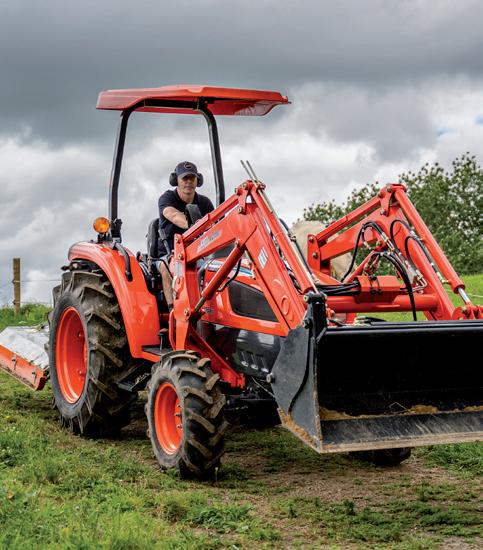
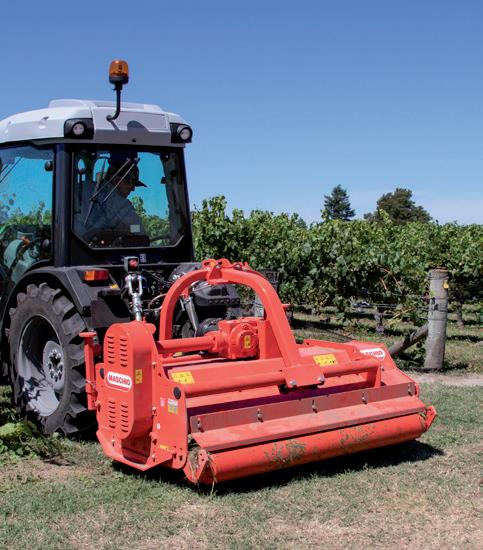


Visit us at our purpose built building at the Riverlands Truckstop, 3535 State Highway 1, just out of Blenheim.
Our experienced team now have a state-ofthe-art workshop to ensure your gear is always ready to work hard for you when you need it. Does that Silvan Sprayer need a service? We do sprayers, to tractors, right through to construction equipment. Give us a call or drop in, we service most makes and models and can have most parts for you in under 48 hours. Make sure your equipment is ready to work as hard as you do.



THE 2022 vintage marked a technology turning point for New Zealand wine behemoth Indevin Group, as it looked to data to help navigate a record-breaking harvest, the complexities of climate change, and the addition of Villa Maria to its logistics.
The biggest lever they could pull was to harvest effectively, “and try to harvest as much of the supply in the right condition at the right time”, says chief technology officer Peter Terpstra of New Zealand’s largest ever harvest, in which Indevin accounted for 20% of the whopping 532,000 tonnes yielded nationwide. “To do that we need all the harvest logistics — of the harvester, the trucking companies, and the wineries — to be working in tune. And of course they are at different cadences.”
“It’s the constant live data streams that allow us to keep everything in balance. We believe every year we are getting better and better at that.”
Peter Terpstra
They worked with Amazon Web Services (AWS) to absorb, analyse, and present their data, so that winery teams could track progress from vineyards, harvesters and trucks, with a “single source of truth” for every aspect of the harvesting process. Having dashboards with real time information allowed crews to “react in real time”, then later analyse any changes required, Peter says. “That was one of the critical parts of surviving that harvest.”
Two years on, winery and harvest teams are well versed in the system, tapping into live data of the 2024 vintage, so that at any given time they could see what the yield predictions were for 17 varieties across 1004 subblocks and 250 vineyards throughout New Zealand, and compare those against actual yields, along with demand forecasts for each variety. They could assess how far through the harvest was on each site, when fruit would arrive where, what the winery capacity was, and the cause of any bottle necks in the process. While the 2022 harvest saw harvesters waiting for the winery, “which was the capacity constraint”, this year’s lighter harvest saw harvesters struggling to keep up, “because they have to drive the same distances and the wineries are being underfed”, Peter says. “It’s the constant live data streams that allow us to keep everything in balance. We believe every year we are getting better and better at that.”
Internet of Things (IoT) sensors provide real-time data on wine presses, loading bins, pumps, flow meters, and temperatures, and have enabled Indevin to improve its throughput by 30%, thanks to the ability to match the harvest output to grape processing and storage capabilities. The system also provides early warnings to teams during harvest, helping them manage adverse weather conditions and production issues, while optimising ground teams. By next year, Peter expects the company’s harvesters to start weighing fruit on the hop, allowing the company to collect and assess vineyard data on a micro scale, seeing what pockets of each subblock are doing well compared to others, in order to make changes where possible. That’s a “complete sea change”, Peter says. “It provides the missing piece for being able to optimise vineyard performance which is the big prize.” He hopes to have five of those harvesters for the 2025 vintage, and to upscale that ability going forward.
Peter says Indevin has long been on the front foot with technology, having built its own winemaking system in 2009. “The tech journey started way back then.” They are now increasingly looking at cloud technologies and AI solutions to “future gaze”, including in managing the challenges of climate change, with vintages already much more compressed as the weather changes. His favourite saying is that simplicity is on the far side of complexity not the near side, “It’s a good thing to remember of technology. As things get more complex you can’t give up – in the hope that out the other side will be something simple and effective. That’s quite a driving force in our tech department at the moment”
Read Peter’s Vantage Point on the power of data on page 4.


• Located in the Welds Pass the vineyard is noted for producing premium quality sauvignon blanc and hillside pinot noir fruit.
• Planted in 2003 the vineyard comprises 14.4 canopy ha of sauvignon blanc and 8.7 canopy ha of pinot noir.
• The vineyard produces approximately 230 tonnes of sauvignon blanc and 60 tonnes of pinot noir annually. The pinot noir has historically been cropped to wine company requirements.
• The vineyard has low frost and disease risk.
• The vineyard has its own dam with an excellent water source.
• The vines are in good health. Virtually all “big cuts” were green seal protected. The annual mortality rate is less than 0.2% on pinot noir vines and less than 1.0% on sauvignon blanc vines.
• The pinot noir clones are 114, 115, 667 and 777.
• 6ha of pinot noir is on 3309 rootstock and 0.7ha is on 3306 rootstock. Both are suitable for top grafting to sauvignon blanc.
• The soils are good quality and approximately 90% of the hillside canopy exceeds the top of the intermediate posts. Minimal earthworks were done prior to development.
• Our preference is to sell the vines, trellis and parts of the irrigation system and lease the land and other assets to the purchaser.
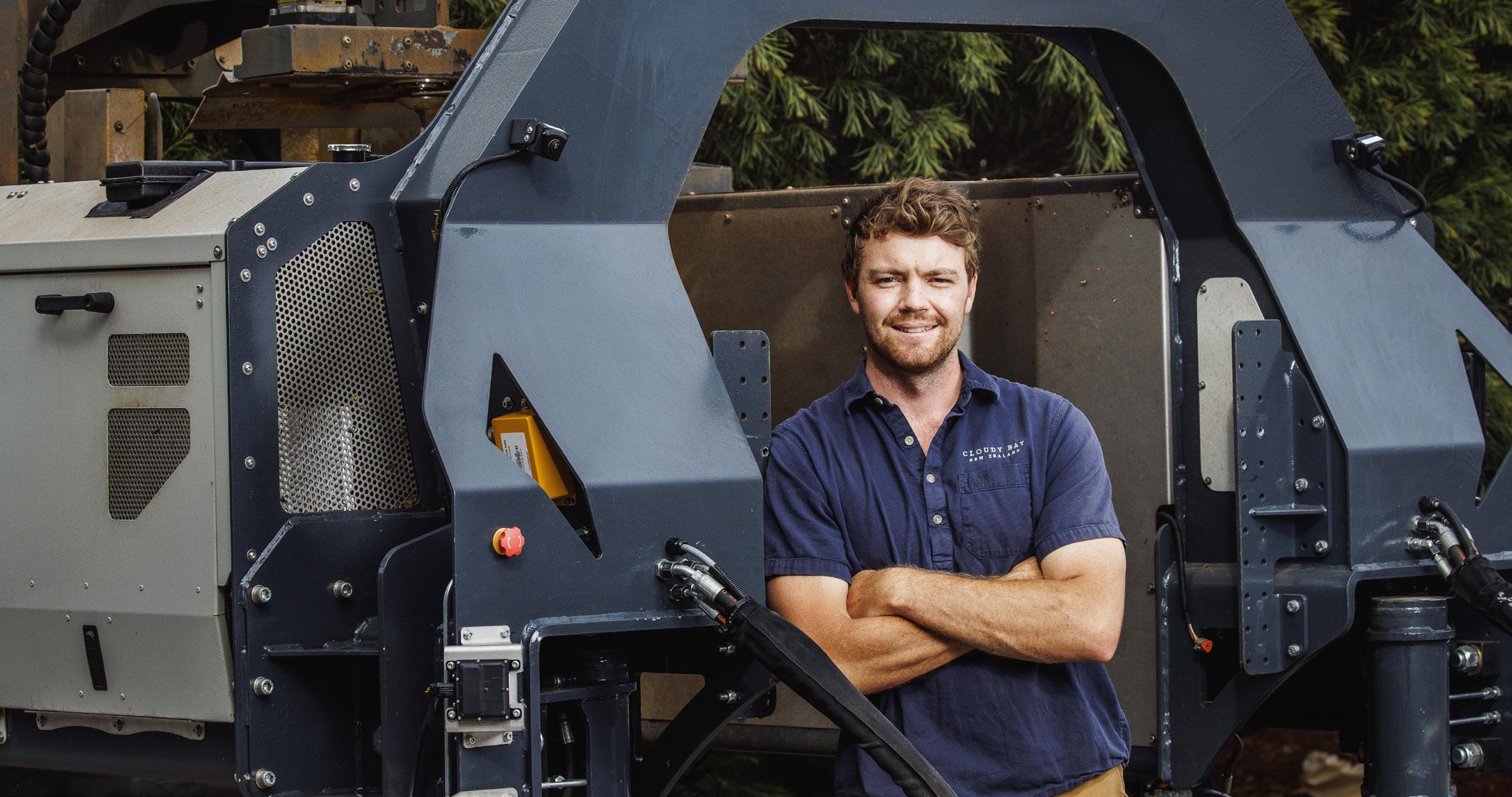
“The quality of the jobs completed rivalled that of conventional tractor operations.”
Murray Faber
A GLEAMING workhorse trundled up and down the rows of Cloudy Bay’s Mustang Vineyard this summer, single handedly mowing, weeding and trimming the 66-hectare herbicide-free block. “Mechanical under vine weeding is a slow, repetitive, and laborious job that provides a great target for autonomation,” says Cloudy Bay vineyard innovation and engineering manager Murray Faber of V3, the autonomous vineyard tractor he’s developed over the past four years.
The 2023-2024 growing season was a “testbed” to assess whether V3 can enhance the quality and efficiency of mechanised tasks across the vineyard, Murray says. “Throughout the latter half of the growing season, it proved the ability to regularly work for up to 15 hours a day while trimming or under vine weeding. The quality of the jobs completed rivalled that of conventional tractor operations.”
This project started in a Cloudy Bay shed amid Covid-19 labour pressures and the machinery requirements of Cloudy Bay’s herbicide-free trials. “I have always been interested in the meeting point between engineering and agriculture,” says Murray, who pieced together V3’s first iteration from a pile of scrap metal, before sending it successfully up and down vineyard rows. “The build and operation of each protype has resulted in invaluable learnings over the years. We are finally approaching a solution that is well suited to New Zealand growing conditions and our operating requirements.”
V3 is designed to straddle the vine rather than run between rows, which offers many benefits, including reduced ground compaction and compatibility with all row widths, Murray says. The latest version has four-wheel steering, allowing it to turn from row to row without skipping, and has capacity for running multiple implements simultaneously, from weeding and mowing to trimming and plucking, along with data collection, all fitted inside its “tunnel”. A key design consideration from the early stages was multi-tasking, where as many jobs as possible can be done during a single pass, Murray says.
He notes that a lot of effort has gone into the development of the machine’s perception system, which allows it to build a virtual 3-dimensional map of its surroundings accurately and reliably. This is done by an array of sensors, including Lidar, radar, and cameras, resulting in a reliable safety stack capable of detecting people or objects in the machine’s path. “V3 streams a host of diagnostic and telemetry data, including live video feeds, to an online cloud platform. This enables the machine to be monitored from anywhere in the world. Multiple machines can be supervised by a single operator, or an operator can focus on other vineyard jobs while checking in to a machine periodically.”
There are lots of changes in line for V4, including continual software development, added versatility for different implements, and a more powerful, efficient, and lower emissions engine. The current design is diesel, because of the high energy requirement for running powered implements, but Murray will work towards hybrid and electric options as they become more viable. The project has been a “dream” experience, he adds. “I have absolutely loved it.”
Brock Campbell, Cloudy Bay’s vineyard sustainability and operations manager, says V3 makes the company’s sustainability ambitions more viable. “It frees up our staff to do more technical work and higher skilled tasks. It’s a shining example of when management gives the green-light for innovation, and when those guys who have their boots in the soil come up with the good ideas.”

Sale By Negotiation
263 Chaytors Road, Spring Creek, Marlborough
Located in a proven viticultural location surrounded by several established producing vineyards within close proximity to Blenheim CBD. Currently leased by a prominent, internationally recognised wine company allowing for a hands free vineyard investment and monthly income. 8.23ha Pinot Noir vineyard comprising of approximately 15,252 plants. Refurbished smoko shed. Several sites to build a new dwelling if so desired.
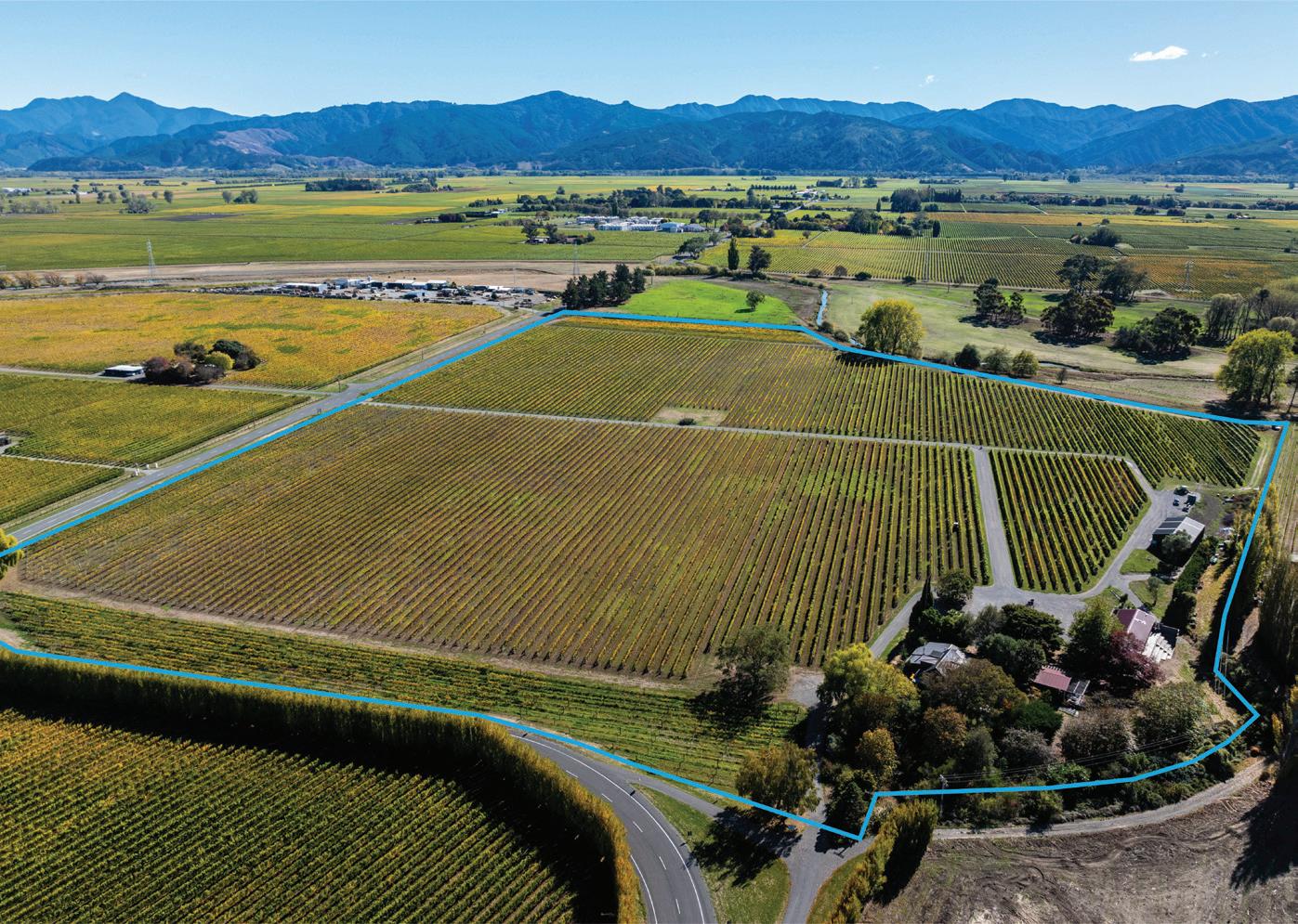

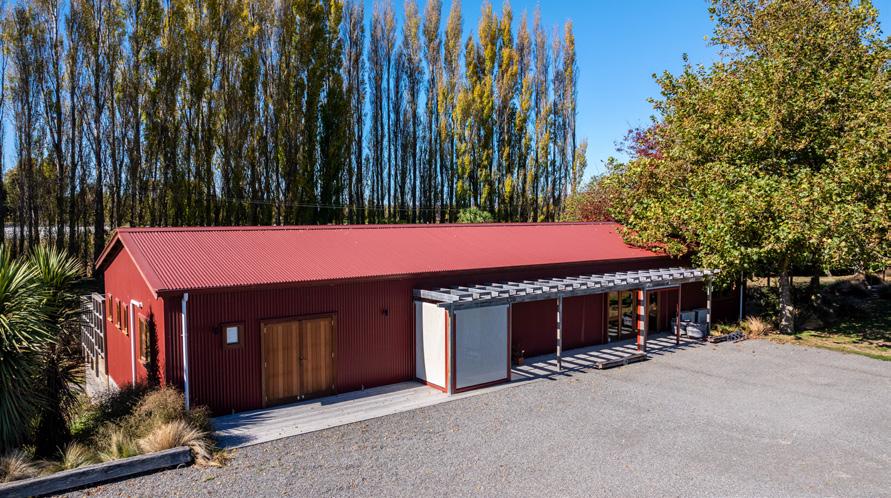
For Sale by Deadline Sale closing Friday 31 May 2024 at 2pm (unless sold prior)
80 Hammerichs Road, Rapaura, Marlborough
Seldom available 16.6ha in two titles located in desirable and tightly held Rapaura. The current mixed varietal certified organic vineyard sits on fertile deep silt loams renown for producing reliable yields and desirable wine styles. Supported by a converted residence currently operating as a restaurant, additional consented new cellar door and function centre. A seldom available value add vineyard redevelopment opportunity with additional income streams in the heart of Marlborough’s internationally acclaimed wine region.
FINISHING TOUCHES are being made to a future-focused vineyard lab built and owned by the Marlborough Research Centre and operated by Plant & Food Research.
The facility, which will be officially named and opened on July 26, is being developed alongside the Bragato Research Institute winery in Blenheim, with a retractable rain shelter in the shape of a massive barn, a movable crane, and 48 holes, to be filled with pots holding soil, plants, sensors, and access points in order to test and sample the soil and root system. Results will be used to understand soil type, vine root and cover crop interactions, enabling better adaptation to future climates.
Plant & Food Research science group leader for viticulture and oenology Damian Martin, who is leading research in the facility, says the first third of the experimental vineyard will be filled this winter. He says the research team will pick up to four soil profiles important to the Marlborough region to get different growing mediums. “Where the soils are all silty, we should be able to core them and get as much in situ soil, vine and root system as we can.”
Each pot will have an array of sensors, including soil moisture tubes for root growth observation, as well as access points to biopsy roots and the rhizosphere. “By spring, we’ll have plants growing… It’s going to be a fantastic facility.”
The initial planting will likely be in Sauvignon Blanc vines, but Damian says the facility’s door is open for any kind of perennial horticulture plant. “A lot of what we’re interested in is of benefit to a wide range of sectors.” The facility has the capability to simulate climate change, including advancing growth by up to four weeks, he adds. “Soil and

irrigation water management will be studied in detail, in line with central and local government priorities relating to protecting natural resources for future generations.”
The Budge Street campus will become a world-leading hub for research and innovation, serving both local and international needs, Damian says, noting it will be shared with NMIT, and there will be students studying and working at the facility as well.
“There’s no other place that has facilities like Bragato research winery and this facility, side by side. The campus is going to be a magnet for collaboration, carrying out critical and impactful research, developing students and teachers, and a great place for overseas researchers to come.”
The vineyard lab is one of the projects being presented at WinePRO in Blenheim from June 25 to 27. Plant & Food Research science group leader for viticulture and oenology Damian Martin says sharing industry research with those in the field is vital. “It is very important to make the wine industry aware of the need for long horizon, underpinning research to answer questions that relate to balancing the economic need for intensive grape production systems with good stewardship of the environment for future generations.”
The project overview will be found at stand stand C15. winepro.co.nz



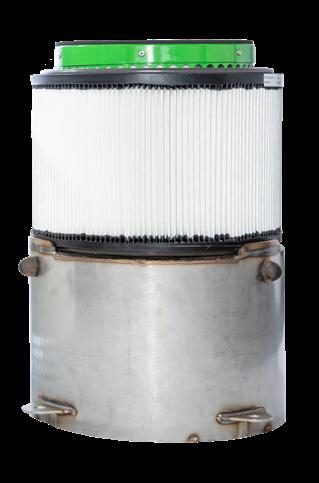

Breathe clean and work safe with Freshfilter's innovative cab air filtration systems.
Our technology ensures:
• A constant positive pressure environment, keeping dust and contaminants out.
• Improved air quality for operator comfort and well-being.
• Enhanced focus and productivity throughout your shift.
Invest in your health and safety. Choose Freshfilter Cab Over-Pressure Systems today.


“We thought we didn’t need it; but the guys are so much fresher at the end of the day.
“Now we have the new game-changer. This is the next level for driver comfort.”
- David Kean, Farmers Dipping Ltd
SAVE UP TO $945 ON SELECTED PACKAGES*

Many Marlborough grapegrowers dodged a bullet in the 2024 grape growing season, with irrigation supply largely maintained despite tinder dry conditions. Marlborough District Council environmental scientist, hydrology, Charlotte Tomlinson, and senior environmental scientist, groundwater, Peter Davidson, share some insights.
What was the situation for Marlborough rivers and aquifers this summer?
Rainfall in Blenheim and much of Marlborough has been below average since mid-2023, so pre-summer the larger rivers in Marlborough (Wairau, Waihopai, Awatere) already had lower than average flows for the time of year. Particularly in the Wairau River, water users were very fortunate that the minor but well-timed rain events we received over summer largely kept river flows above the minimum flow at which all irrigators must cease taking water. Low rainfall over such an extended period (from mid2023) led to a lack of small to moderate flood events in the Wairau River, directly affecting the rate of channel leakage and recharge to the Wairau Aquifer.
Were some growers impacted?
In the Awatere Valley, vineyards with Class B water permits were unable to take water for a 60-day period (on-andoff) from late January to early April, leaving these growers reliant on stored dam water for irrigation. Those with Awatere Class A water permits were rationed to 80 or 90% of total daily water allowance for several weeks throughout summer to ensure the minimum environmental flow at the river mouth was maintained. In the Wairau Valley, those with Class A Wairau River water permits were unable to take water for 16 days from late March to early April. Tied to the same river flow restriction, the Southern Valleys Irrigation Scheme was also shut down for 16 days in total. Marlborough District Council (MDC) received several reports of shallow wells drying up over summer, which were mostly smaller domestic supply wells.
What was the state of the Wairau Aquifer?
The Wairau Aquifer experienced its lowest groundwater levels on record this summer, which includes data going back to the early 1970s for one monitoring well, and for most others around 25 years of data. Interestingly the highest groundwater levels for the same wells occurred in 2022, showing the large aquifer range under contrasting seasonal conditions. The cause of the low levels this summer was record low rainfall, low Wairau River flows from mid-June 2023, and very high groundwater demand. These seasonal

factors were superimposed upon the long-term declining trend in Wairau Aquifer level, in effect since at least the early 1970’s, to give the lowest aquifer levels on record. The cause of this long-term decline is thought to be historic river management, changing the river’s characteristics which has unintentionally caused a decline in aquifer recharge. How is council responding to the decline?
MDC has been aware of the declining aquifer trend for some time, and the Wairau is one of three case studies in the Gravel Bed Rivers National Research Project (GBR), funded by the MBIE Endeavour Fund. The findings of the GBR project will be applied in collaboration with the MDC Rivers and Drainage team. One proposed method to manage the aquifer decline is building river-bed gravel levels up through the recharge reach of the Wairau. This process depends on the natural supply of gravel arriving from the upper catchment and management of gravel extraction in the recharge reach. Restoring the natural equilibrium of the Wairau River will also involve reducing river channel incisement, which currently hinders aquifer recharge. How much water is removed from rivers and aquifers in Marlborough now, compared to 20 years ago?
It’s difficult to answer this question precisely as there aren’t complete records of metered water use grouped by aquifer or river catchment. Based on the expansion of vineyard area now compared to 20 years ago, its likely there has been a significant increase in irrigation water use in the Wairau Valley. In the 2023/24 season, demand would have been near its peak, with high evapotranspiration and low rainfall. Dry conditions from November onwards meant demand was high from early on in the season.
What role does the wine industry play in protecting water resources?
Wine growers have an important role to play in making sure clean water is there in sufficient quantities for everyone for the future, for example through continued research and
innovation into efficient use of water for irrigation and application of nutrients. Although it’s an obvious point, vineyard owners can also help to protect water resources by abiding by their consent conditions, such as not taking excess water or when restrictions are in place. They can also help by ensuring water meters are calibrated regularly and recording accurately – this information is crucial for us when assessing the effect of consented abstraction on our water resources.
The grape harvest will generally be earlier in the year due to higher temperatures, meaning the water demand pattern for irrigating and processing the crop will change over time. Water availability will likely be the limiting factor on production across the primary sector, with time spent in drought expected to increase to 2090. This will lead to greater reliance on stored water to get through dry years. Increased wildfire risk will likely be an issue, so the balance between water stored for irrigation and firefighting will have to be carefully managed. It is hoped that climate-related implications on water use and demand will be assessed in more detail as part of collaborative studies between MDC and the Marlborough Research Centre using their new glass house facility (see page 18). Low-cost technology should be explored to provide higher resolution data in vineyards, enabling more precise and efficient irrigation. At the opposite end of the spectrum, short duration heavy rainfall events are expected to increase in frequency, which should have the benefit of increased rates of aquifer recharge but may have the disadvantage of increasing the risk of surplus water in low lying or built-up areas.
Taking a collective approach to Freshwater Farm Planning will lead to better and more efficient outcomes for winegrowers, says the head of an initiative to enhance vineyard waterways.
Project Raumatatiki will work to integrate Freshwater Farm Plan requirements into the existing Sustainable Winegrowing New Zealand (SWNZ) programme as much as possible, developing an industry specific tool to help winegrowers develop individualised plans that identify risk and vulnerabilities from vineyard activities, along with mitigations to address them. “Our industry prides itself on being collaborative, innovative, and forward thinking,” says Fabian Yukich, deputy chair of New Zealand Winegrowers (NZW), who is leading the project alongside representatives from three grape growing regions, and central and local government. “Working together on creating cleaner natural waterways is an evolutionary step for our industry and the SWNZ programme”.
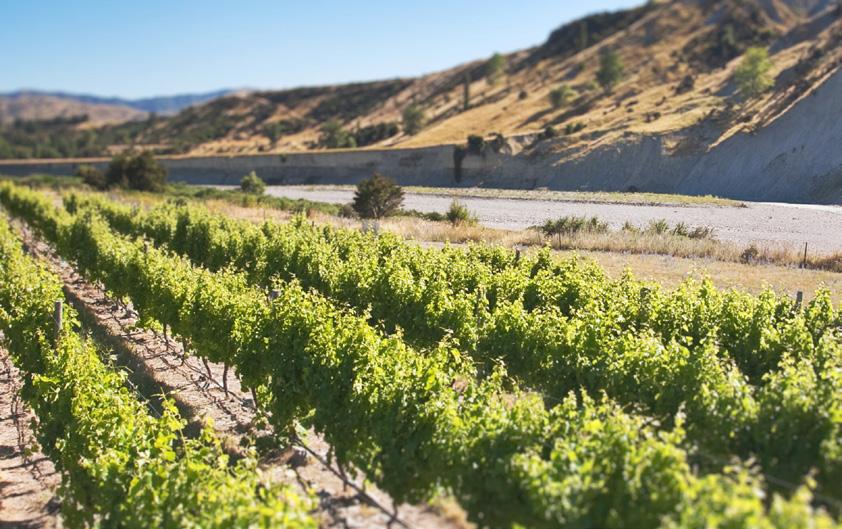
Dr Edwin Massey, NZW general manager sustainability, says the New Zealand wine industry is recognised globally as a world leader in sustainable production, with SWNZ certifying more than 96% of vineyard area. Project Raumatatiki will minimise costs and provide comprehensive support in navigating the regulations, he says. “We see this positively, as it offers an opportunity to further enhance our industry commitment to the environment through caring for our natural waterways and the supporting ecosystems”. NZW has received funding from the Essential Freshwater Fund, administered by the Ministry for the Environment. “This will support us with including education and on-the-ground advice to our members,” Edwin says.
Will Macdonald, Rangitāne o Wairau, sits on the governance group. “Through Project Raumatatiki we have an opportunity to embody rangatiratanga (leading the industry in this space), kaitiakitanga (positive change to sustaining natural resources) and kotahitanga (unity among the industry for a collective purpose),” he says. “The project name derives from the kupu ‘raumatatiki’, which refers to unfailing and endless freshwater springs. Here, it acknowledges the importance of our water that has and will continue to sustain Aotearoa and the wine industry.”





YOU MIGHT not be able to change your personality or your workload, says Nick Petrie. “But you can change your habits of mind.”
Wine Marlborough and Marlborough District Council brought Nick to Marlborough last year for the Grow Perform Sustain workshop, in which he shared findings from a twoyear global research project exploring high performance and sustained well-being. He will return on May 15 to build on that session, zeroing in on stress, and what causes some people to feel overwhelmed by external pressures, while others come through the same environment and workload unscathed.
The workshop will highlight the eight attributes found in 5% of the 1,000 people Nick surveyed in 2023, with that small group recognised for low stress in pressured jobs. “I was very interested in people who were high performers or had big roles, but their burnout risk scores were very, very low,” says Nick, whose clients include Google, Walmart, and NASA. In most workplaces burnout scores came out high, with people reporting an inability to switch off at the end of the workday, blurred boundaries between work and home, and a feeling of overload. Some of the 5% who bucked that trend had experienced a burnout incident in the past, or had come close to one, but all had at some point stopped and considered the situation, then made a decision about how they wanted to work, he says. “They were very reflective.”
The eight habits include high performance and dedication while at work, but also making peace with not getting everything done, Nick explains in a LinkedIn post on the research findings. “Early in their careers they prided
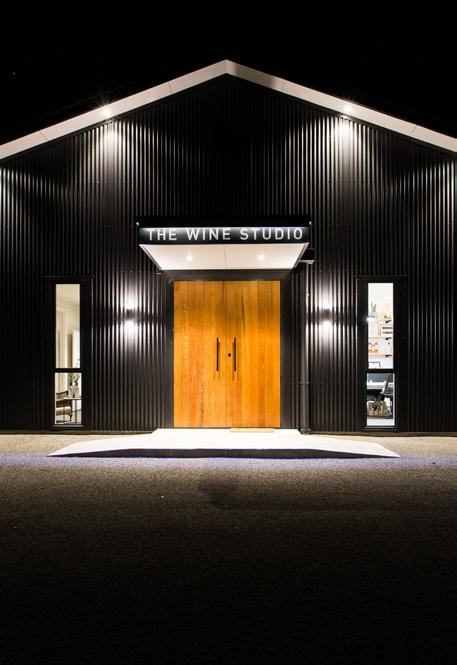

themselves on completing everything each day. As they got into bigger jobs, they learned they had to let that go. Now they prioritise in the morning, do all they can, and leave what’s incomplete for tomorrow.” They also have a “ritual” to switch from work to personal mode, and have clear boundaries between work and home. In the past, those respondents had blurred boundaries, but are now “vigilant” about shutting off work at home, including strategies for phone-free time.
Nick says the attributes that drive success early in a career can be the same ones that “burn you out” later on. “In your 20s if you are a relentlessly hard worker, you will do whatever it takes; you’ll say yes to everything; you will take everything on. That’s great and it makes you really effective at what you do.” But his research has shown that people who carry those work habits through as they get older, with bigger roles, more responsibility, and perhaps a mortgage, children, and aging parents to take care of, put themselves at risk. If they haven’t learned to update their approach to work, and operate “in much smarter ways”, they are at high risk of burn out, Nick says.
When it comes to his impressions of the wine industry, Nicks says “passion and purpose” can spiral into issues as well. “When we did the research, we found in relation to burnout risk, when people were doing work which was out of alignment with their values, they became quite irritated, angry, resentful about how hard they were working.” But at the other end of the spectrum, people who felt very aligned with what they were doing – as many in the wine industry are – were also at risk. “Because they would keep working
and working and working and were not very good at pumping the brakes. That turned out to be a really important one.” Nick often works in corporate environments, where there’s little change from month to month, “with a sort of grind at the same pace at all times”. In contrast, the wine industry is constantly shifting gears, including “very intense periods” throughout the year, complicated by aspects that are out of their control. “I think in a normal business you’ve got your hands on most of the levers. But it does seem from the people I spoke to, you really need to learn to make peace with that; that you can’t actually control nature.”
Nick’s path to leadership and resilience research came through a cancer diagnosis in his 20s, when he was playing rugby abroad. “I was extremely stressed out,” he says of the reoccurring cancer, reflecting on the impact that stress had on his health and immunity. A meeting with an academic changed that completely, giving him tools to manage his reaction to external pressures. “I did what he told me and my stress level went from 10 out of 10 to zero,” he says. The experience changed his outlook and his career. “It really got me focused on doing something useful.”
Nick Petrie’s Grow Perform Sustain – Next Steps workshop will be held on May 15 For more information go to business.marlboroughchamber.nz/eventcalendar
The Marlborough Wine Industry Wellness Week is on from May 27-31, with industry members invited to share their wellbeing strategies on Instagram. A panel of independent judges will select the best initiative, with the winning company recognised on the final day. Last year Spy Valley took top honours for Taco Tuesday, after the entire team of 35, including vineyard, winery and office crews, connected during a Mexican feast in the wake of harvest. From there they went through to the winery for a preview of the 2023 vintage straight from tanks and barrels, gleaning insights into the wines, but also the technology at use in the winery and lab. Judges noted that the simple event touched on several aspects of the Five Ways to Wellbeing – connect, take notice, give, keep learning, be active. Read more in the June 2023 edition of Winepress. marlboroughwinenz.com/wellness-week



When the Matthews family were deciding on a name for their property more than a century ago, they took inspiration from a series of waterways weaving through the landscape. The streams are long gone, but these days Riverby Estate lends its name to a “passion project” wine label. KAT PICKFORD talks to co-owner Kevin Courtney about the business of boutique winemaking.
IN A region renowned for its Sauvignon Blanc, boutique wine businesses play a crucial role in showcasing the vibrant array of lesser-known varieties. However, artisanal producers are becoming increasingly rare in the face of rising fixed costs, with the price of scaling up out of reach for many, says Riverby Estate co-owner Kevin Courtney. “Looking back to when we first started, most wineries in Marlborough were small, family-owned businesses. But the small wine companies are disappearing, while the bigger companies are getting bigger and bigger.”

Riverby Estate remains a family-owned boutique producer and takes pride in providing a point of difference for open-minded consumers keen to look beyond Marlborough Sauvignon Blanc, Kevin says. “Marlborough is so unique; we can grow almost anything here except the big reds. There’s hardly anywhere else in the world you can do that.” But with 18 wines in production (although not all are made every vintage) the wine label is more of a “passion project” than good business, he adds. “We probably don’t make any money making wine; the grape growing side of the business compensates for that.”
Located on the sandy, free draining soils around Jacksons Road in Rapaura, Riverby Estate has been owned by the Matthews family for more than 130 years. Like most of Marlborough, the land was traditionally used for cropping and sheep farming, before grape growing became the next big thing in the 1980s. With neighbours including Cloudy Bay and Allan Scott planting grapes around them, the Matthews family decided to do the same, and established their first 2.5 hectares


is also naturally frost free and sits directly above the Wairau aquifer, which helps reduce costs and takes the pressure off during flowering and through the drier summer months.”
For the first 10 years, the Matthews sold their fruit to Auckland wine label Collards, and didn’t start making their own wine, a Sauvignon Blanc, until 1999. Dr John Forrest provided winemaking services and tank space and the Matthews provided him with fruit – a partnership that continues to this day, some 25 vintages later. Over the years Riverby Estate extended its range to include a veritable who’s who of wine varieties that can be found in Marlborough. “I know on the world-stage we only produce a tiny drop in the ocean of the world’s wine, but it seems a real shame that we have such a monoculture in Marlborough and it’s potentially a very dangerous thing. That’s why small, family-owned producers like us are so important –showcasing what can be done and providing some diversity for people who simply aren’t Sauvignon Blanc drinkers or who want to try something different.”
Kevin, who is married to Christine, a fourth generation Matthews, first joined the wine business as a “wine enthusiast” in 2005, to help with the logistics of the growing company. Back then all of their wine was sold in Australia, while most Marlborough wineries concentrated on the United Kingdom and United States markets. But after the enormous yields of 2008, followed by the Global Financial Crisis, Marlborough wineries found themselves
with a glut of wine and suddenly Australia was awash with Marlborough Sauvignon Blanc. Prices have never recovered, Kevin says. “Our Sauvignon Blanc used to sell for about $25 a bottle back in 2006, but after the double whammy of the huge harvest in 2008 and the GFC, many Marlborough Sauvignon Blancs dropped to about $14-$15 a bottle by 2012 and that intense competition had an inevitable affect on our sales.”
Riverby Estate gradually “retired” its wines from Australia and now its biggest markets are Korea, UK and Hong Kong, with only a small portion sold across the ditch. “People are paying less for a bottle of Sauvignon Blanc now than they were 20 years ago. But the irony is, Marlborough’s making better Sauvignon Blanc now than it ever has,” Kevin says.
As a small producer, Riverby Estate doesn’t have the volume to compete with supermarket-priced Sauvignon Blanc and instead has focused on producing a wide range of premium, single vineyard Marlborough wines, including its award-winning sweet wines and Rieslings, and unique “Rapaura style” Sauvignon Blanc. “People can have these funny ideas about wine, like ‘all Rieslings are sweet’ or ‘all Chardonnays are oaky’, and we love challenging those perceptions and giving people something unique to try,” Kevin says. “As a small producer, we’ve had to carve out a bit of a niche for ourselves, so that’s what we try to docreate distinctive wines that stand out from the crowd.”


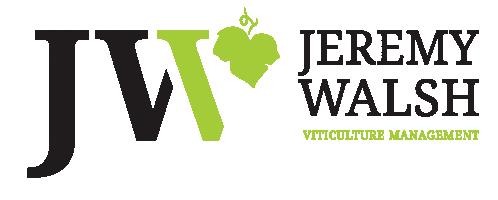




WITH MANY different facets converging in a space where art meets science, wine is an infinitely diverse and interesting industry, says the new assistant research winemaker at Bragato Research Institute.
Rob Winup joined the wine research team in Marlborough in August last year and has enjoyed the opportunity to step into the unique role, which encompasses a variety of responsibilities and disciplines. Born and raised in the United Kingdom, Rob, who has a degree in social anthropology, fell into the world of wine after working in wine retail for a number of years, and studying for his WSET levels 3 and 4.
Perhaps it was the influence of his father, a wine and food enthusiast, but after a string of odd jobs, wine was the first industry he worked in that felt like a good fit, Rob says. “Dad is a real foodie and loves his wines; he was probably more excited than I was when I told my parents I’d decided to study winemaking.”
While Rob was studying for a bachelor degree in Viticulture and Oenology at Plumpton College in Lewes England, he picked up work as a vineyard hand at Breaky Bottom, a small winery in England known for its Champagne-style sparkling wine. While taking a gap year and working at Kingscote Estate and Vineyard, he researched his options and decided to continue the third year of his degree at Nelson Marlborough Institute of Technology in Blenheim. “I thought I might as well roll the dice and see how it worked out.” After arriving in January 2020, Covid hit “and the world changed”, Rob says. “But I decided to stay. Marlborough felt like a great place to be.”
After graduating, he picked up a cellar hand role at Wither Hills for the 2021 harvest, then a permanent position with the cellar team. In mid-2022 he took the opportunity to apply for a laboratory role at Wither Hills before joining the wine research team at Bragato in August 2023.
“The role interested me because it is so varied, from cellar operations and lab analyses to office admin and management,” Rob says. “After working in the vineyards, then with a cellar team then the lab, it felt like a logical progression and a good fit for me.”
While all the winemaking trials are small-scale, the scope is wide, he says. “This year we booked out more than
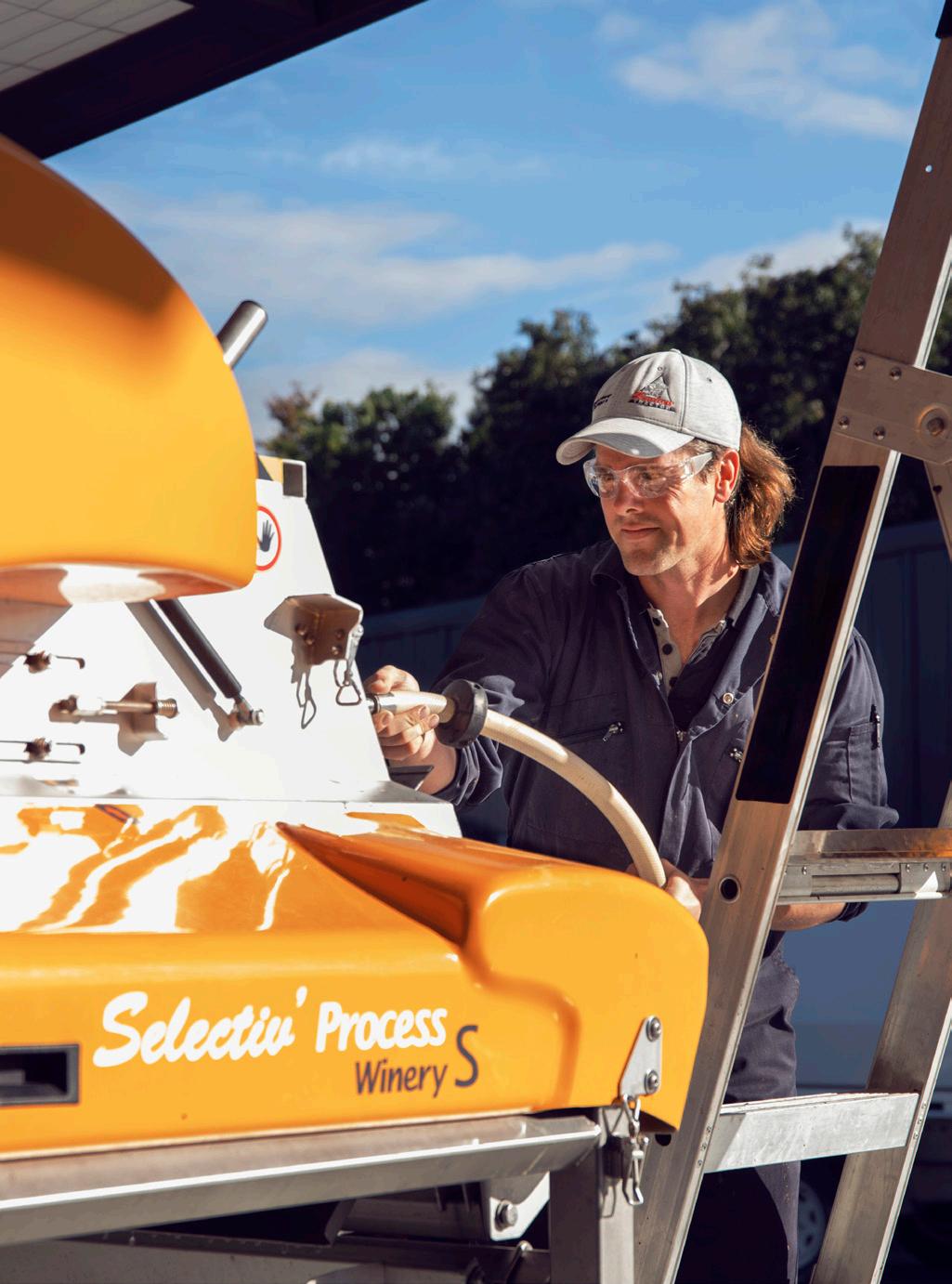
“This year we booked out more than 250 ferment lots, with a huge variety of fruit for a variety of research work.”
Rob Winup
250 ferment lots, with a huge variety of fruit for a variety of research work.” Vintage was “full on” at the research winery, with the four permanent staff joined by an extra cellar hand or two during the busy period. From the miniature receival machine to the tiny 100kg presses, through to the 17 litre ‘tanks’, the winemaking process in the research winery mimics the process in a commercial winery as closely as possible.
After the wine has fermented and been stabilised and bottled, there is little time for rest, with continued analyses, report writing and sometimes sensory testing to be carried out, throughout the rest of the year. While it’s “too soon to say” which winemaking path he will take in the future, Rob is enjoying his role and soaking up as much information as he can from his colleagues, who have been “hugely generous” sharing their knowledge and experience with him.
SUPPLIERS OF:
n Vineyard posts & strainers
n Quality timber products
n Utility buildings - designed for your needs
n Locally owned
n Working towards the betterment of Marlborough
163 Hammerichs Road, Blenheim Ph 03 578 0221 Fax 03 578 0251 sales@rapauratimber.co.nz

COLDSTORES LIMITED
Let us take care of all your controlled Temperature storage requirements:
◆ Custom controlled area
◆ Approved Transitional Facility for unloading of Imported Containers
◆ Over 60,000 cubic metres of storage spread over two sites.
◆ Chilled storage available during vintage for handpicked grapes.
◆ Sophisticated monitoring equipment ensures your product is kept at the optimum temperature.
◆ We could lease you a small room for your exclusive use to suit your particular temperature requirements (0 o C to + 30 o C).
◆ We store bottled wine, barrels of wine and new plants awaiting the opportune time to plant.
◆ Individual rooms available to grow new budwood.



Warm and Chilled Glycol Systems
Design & Build Mechanical Services
Heat Recovery Systems
S/S Wine and Juice Lines
Water Treatment and Filtration
“Over 15 years experience serving the Marlborough wine industry ”

‘IT TAKES all of us to protect what we’ve got’ is the tagline of the national Ko Tātou – This Is Us biosecurity campaign and rings true when you consider what the New Zealand wine industry has to lose from a serious biosecurity incursion. With more than $2.4 billion worth of exports in 2023, and a reputation for premium, sustainably produced wines coming from the grapes of more than 2,000 vineyards across the country, biosecurity cannot be someone else’s job – we all need to do our bit. Everyone in the industry must have an understanding of what biosecurity is and how to play their part to help prevent the arrival and establishment of unwanted pests and diseases.
Biosecurity needs to become business as usual for all wine businesses, embedded into day-to-day activity the way health and safety requirements are. There are many simple measures that growers and winemakers can implement, reducing the risk of biosecurity issues on their own property and contributing to the national effort to help keep New Zealand free from invasion by harmful pests and diseases. Building a biosecurity culture at your workplace now will put you in a strong position to protect your assets against any exotic pests and diseases that may manage to pass through New Zealand border systems in the future.
• The New Zealand Winegrowers (NZW) website (nzwine. com) has a Biosecurity section for members. This is regularly updated and contains a lot of information about current issues, research, and how to protect your vineyards, as well as posters and factsheets about pests and diseases. Become familiar with the website and visit it regularly as a way to keep up-to-date.
• Make sure you are informed about the current Most
Unwanted pests and diseases for the industry. Know what to look for, and where to look. Know what to do if you find something unusual. Pass this knowledge on to your staff/co-workers – include it in induction processes for anyone new working on your site. Display posters and factsheets in communal areas for easy reference.
• Attend a biosecurity workshop or host the NZW Biosecurity team at your site to brief your staff and contractors. There are often biosecurity sessions at industry events such as Spray Days and Grape Days.
• Request a Biosecurity Resource Pack (free for NZW members) by emailing your details to biosecurity@ nzwine.com. This pack has everything you need to get started with implementing biosecurity best practice in the vineyard.
• Inspect vines, fruit and neighbouring vegetation regularly for pests and disease (exotic as well as those already present in New Zealand). Ensure staff are familiar with existing crop pests, so they will know when something is unusual. Encourage them to take photos of Xylella fastidiosa infection in chardonnay vine – image credit Lindsey Burbank, USDA-ARS.




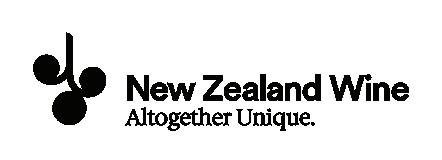
anything suspect and note the location.
• Establish a process whereby staff know what to do if they find something suspicious or usual – do they contact Biosecurity New Zealand immediately, or do they let management know first? Get staff to put the biosecurity hotline number 0800 80 99 66 into their phones and/or download the Find-a-pest app (which can also be used to report anything usual).
• When planting new or replacement vines, ensure you purchase vines certified under the Grafted Grapevine Standard. Inspect the vines (or a representative sample) on arrival before planting and get in touch with the nursery immediately if you notice any issues.
• If buying other plants to plant in or around the vineyard or cellar door, purchase from nurseries certified with the Plant Pass biosecurity scheme.

• Limit vehicle use in production areas – have a designated parking area away from the vines for visitors. Consider using a site vehicle to transport visitors around and having set vehicle pathways. If possible, wash down vehicles coming onto/leaving your site to avoid spreading soil, insects and seeds.
• Inspect and clean machinery before it enters production areas. If importing machinery from overseas, open and inspect for pests it in an enclosed area before use.
• Train staff in tool hygiene procedures – sterilising hand tools between blocks and moving from least-diseased to most-diseased blocks when carrying out tasks like pruning.
• Footwear – provide a wash station where staff and contractors can clean their footwear before walking amongst the vines. A disinfectant spray such as Virkon is a good option, along with water and tools or brushes to remove clumps of soil and plant material.
• Make biosecurity a regular part of your day-to-day conversations with staff – take the time to ask if they have noticed anything unusual out in the vineyard. Once engaged with biosecurity, your people are the best source of new ideas for managing biosecurity risk.
• Make use of signage. Having biosecurity signage that clearly states what you want visitors and/or staff to
do when arriving at or working on your site provides a visual reminder that biosecurity is important. Businesses such as The Signmaker (thesignmaker.co.nz) stock useful, relatively inexpensive biosecurity signage and can also custom-make signs on request.
• Make a point of talking to contractors regularly about biosecurity requirements for your site such as washdown of equipment, cleanliness of footwear and tool hygiene. By following good biosecurity practices, they are helping to protect the future of the industry that supplies them with work; biosecurity is in everyone’s best interests. A Contractors Biosecurity Guide is also available by emailing biosecurity@nzwine.com (and available on the website too).
“Biosecurity needs to become business as usual for all wine businesses.”
For any questions or assistance with vineyard biosecurity, or to request biosecurity resources, contact the NZW biosecurity team on biosecurity@nzwine.com. And if you notice anything unusual, remember to Catch It, Snap It and Report It to the Biosecurity NZ hotline on 0800 80 99 66.


Whitehaven has been recognised as a Hot Brand award winner in the March 2024 issue of Market Watch Magazine, which recognises the fastest growing drinks brands in the USA. Whitehaven was the only New Zealand wine brand to make the list and one of only four imported wine brands recognises in this year’s awards. Whitehaven chief executive Steve Ross says Whitehaven has appeared on the Hot Brands list every year since 2016, “despite challenging economic conditions in recent years”. Whitehaven has been successfully exporting to the United States since 2004 when its first shipment totalled just 5,000 cases. In 2015 Whitehaven celebrated the export of its millionth case to the US, and it now exports more than half a million cases per annum. The Marlborough wine label is the top ultra-premium Sauvignon Blanc and the fourth Sauvignon Blanc brand across all price points, with growth at twice the rate of the Sauvignon Blanc category

Pūteketeke on the Pinot

Marlborough wine company Yealands won the ‘Champion of Champions’ award at The Green World Awards 2024, held in Brazil in March, with wins for Regenerative Practices, Carbon Reduction and Climate Change, and two wins in the Sustainability category. Yealands sustainability manager Andree Piddington says sustainability is part of the company’s DNA. “We have sustainable initiatives across the breadth of our business and supply chain, with clear targets in place and an amazing team working towards achieving our goals.” In 2019 Yealands set their 2050 vision of becoming carbon positive, with an interim target of a 50% reduction by 2030. Since then, they have electrified their irrigation systems, light weighted and increased the recycled content in their glass bottles and are currently expanding their solar capacity - with many more initiatives in the pipeline. “In 2021 we implemented our 30-year, intergenerational biodiversity plan to protect and enhance the natural landscape of our vineyard and region,” Andree says. “The plan covers 270 hectares of land where we will restore waterways and plant over a million trees. We believe through improving biodiversity we are creating an eco-system that is healthier, requires less inputs, and will be more resilient to climate change - and ultimately produce better quality wines."

John Argyle was a fan of the pūteketeke long before British-American comedian John Oliver ran a global campaign for it to become Aotearoa’s Bird of the Century. “We had it before it was famous,” says Indevin Group’s regional area manager, who first noticed a small group of the endangered bird at Bankhouse Estate in Marlborough’s Wairau Valley two years ago. The birds tend to stay on Lake Pinot from winter to early summer, despite most of the population choosing to sojourn on the Southern Lakes to breed. Last year John decided a little more hospitality might tempt them to stay longer, so organised a nesting pontoon, with the design supplied by Marlborough District Council biodiversity expert Mike Aviss. In a double win, the pūteketeke Australasian crested grebe became Bird of the Century 2023 in November and a pair nested on Lake Pinot’s Pontoon this summer, successfully hatching four chicks. John and Mike are now planning some more manaakitanga for the now-world-famous bird, with habitat enhancement planned for the lake. To read more about the pūteketeke’s landslide win, (attracting a whopping 290,374 votes, compared to second place getter the North Island brown kiwi with 12,904 votes) go to: forestandbird.org.nz/resources/bird-century-winner-announced-puteketeke-pandemonium-prevails.
Bottom Line
TANYA POUWHARE Chief ExecutiveIn Marlborough’s bustling wine industry, treating workers ethically isn’t just the right thing to do – it’s essential for our business and our reputation in the community, locally and globally. Despite grappling with reduced tonnages and downward pressures on grape prices this last year, vineyard owners must resist the temptation to ask their labour suppliers to ‘sharpen their pencil’, seeking cost-cutting measures that go too far. Winter pruning accounts for a substantial part of a vineyard’s operational expenses; growers are encouraged to engage in discussions with their labour supplier to come to mutual agreements on price, but please recognise that pushing too far could jeopardise the longterm sustainability of your labour supplier.
The Recognised Seasonal Employer (RSE) scheme is crucial for Marlborough. Every winter, around 3,000 workers from the Pacific and southern Asia return to help us prepare our vineyards for the next growing season. Without them, we wouldn’t be able to keep our vineyards productive and successful. Dealing with this important part of our labour market has become increasingly complicated, particularly with the high volume of regulatory changes imposed by Immigration New Zealand over the past few years as they tack on policy fixups while they failed to complete their more substantive full RSE Policy Review, started in 2017.
Since 2020, New Zealand’s four successive immigration ministers (Lees-Galloway, Faafoi, Wood, Little) bought in new policy to the RSE scheme aiming to bolster worker protections, but inadvertently escalated the operational costs and complexity of the scheme – policies such as raising minimum wages to 10% above the national adult rate for a minimum of 30 hours a week, regardless of skill or work output, and a ‘temporary’ freeze on accommodation rates in late 2022 that’s blown way past its original six-week timeframe. They have created a two-tier employment system where immigration policy supersedes New Zealand entitlements – not really living up to the ‘Kiwis first’ approach.
It’s essential to acknowledge that transferring cost-saving burdens onto the labour supplier, who must shoulder these extra expenses to remain compliant and continue their work, can endanger their business sustainability and operational efficiency. The economic health of vineyards in Marlborough relies heavily on retaining a skilled and motivated labour force. Neglecting worker rights can lead to decreased productivity, lower quality outputs, and heightened recruitment expenditures, ultimately worsening the bottom line for all involved.


$68,490
$56,990+orc

A monthly list of events within the New Zealand wine industry.
To have your event included in the June 2024 Wine Happenings, please email details to editor@winemarlborough.nz by May 20. For more information, please go to the website supplied or email sarah@winemarlborough.nz
2 Wine Tourism post season catch up 5 to 7pm, Wine Marlborough (marlboroughwinenz.com/industy-events/wine-tourism-post-season-catch-up)
3 International Sauvignon Blanc Day (#SauvBlancDay)
9 V.I.N.E – (Vit Info Networking Evening) for the Marlborough Young Viticulturist of the Year Competition 2024 (marlboroughwinenz.com/industry-events/vine)
9 South Marlborough Wines and cheese evening, 4-6pm, The Station, Seddon (southmarlboroughwines@gmail.com)
10 Discover WorkWell, 10am, Marlborough Library Te Kahu o Waipuna (workwell.health.nz/workwell-programme/discover-workwell)
11 Saint Clair Vineyard Half Marathon (vineyardhalf.com)
15 Nick Petrie’s Grow Perform Sustain – Next Steps Workshop (business.marlboroughchamber.nz/eventcalendar)
20-26 Tech Week (techweek.co.nz/about/regions/marlborough)
27-31 Marlborough Wine Industry Wellness Week (marlboroughwinenz.com/wellness-week)
JUNE
12 Horticentre Charitable Trust OWNZ Kelly Mulville Tour (marlboroughwinenz.com/industy-events)
24 Grape Days Marlborough (nzwine.com/en/initiativesevents/research/grape-days)
25-27 WinePRO; Vine to Wine, Marlborough Lines Stadium 2000 (winepro.co.nz)
JULY
4 Marlborough Young Viticulturist of the Year competition 2024 (nzwine.com/en/events)
31 Marlborough Young Winemaker of the Year competition 2024 (nzwine.com/en/events)














Checking the nutrient status of your soil is an important part of ensuring your vines have everything they need to achieve a successful fruit set. Flowering is a very sensitive period, and vine roots must have access to all they need before any active root ush in spring.
Soil sampling and a precise fertiliser requirement provide important information about what may be lacking in the soil.

If you are short on sta numbers over the winter period, the Fruitfed Crop Monitoring Services team can assist with the collection of soil samples.
Fruitfed Supplies does not warrant the information’s accuracy, quality, outcome, tness for any purpose, or applicability to any person’s speci c circumstances. Always use professional advice for critical work or where you are unsure of any information.
Contact your local Fruitfed Supplies team, or visit fruitfedsupplies.co.nz for more information.


